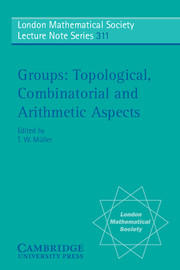Book contents
- Frontmatter
- Contents
- List of authors and participants
- Preface
- 1 Reductive groups as metric spaces
- 2 Finiteness properties of groups acting on twin buildings
- 3 Higher finiteness properties of S-arithmetic groups in the function field case I
- 4 Controlled topology and group actions
- 5 Finiteness properties of soluble S-arithmetic groups – A survey
- 6 Topology in permutation groups
- 7 Euler characteristics of discrete groups
- 8 Intersections of Magnus subgroups of one-relator groups
- 9 A minimality property of certain branch groups
- 10 Lattices with non-integral character
- 11 Some applications of probability in group theory
- 12 Parity patterns in Hecke groups and Fermat primes
- 13 Automorphisms of the binary tree: state-closed subgroups and dynamics of 1/2-endomorphisms
- 14 The mapping class group of the twice punctured torus
- 15 Kac–Moody groups: split and relative theories. Lattices
- 16 On the finite images of infinite groups
- 17 Pseudo-finite generalized triangle groups
5 - Finiteness properties of soluble S-arithmetic groups – A survey
Published online by Cambridge University Press: 04 November 2009
- Frontmatter
- Contents
- List of authors and participants
- Preface
- 1 Reductive groups as metric spaces
- 2 Finiteness properties of groups acting on twin buildings
- 3 Higher finiteness properties of S-arithmetic groups in the function field case I
- 4 Controlled topology and group actions
- 5 Finiteness properties of soluble S-arithmetic groups – A survey
- 6 Topology in permutation groups
- 7 Euler characteristics of discrete groups
- 8 Intersections of Magnus subgroups of one-relator groups
- 9 A minimality property of certain branch groups
- 10 Lattices with non-integral character
- 11 Some applications of probability in group theory
- 12 Parity patterns in Hecke groups and Fermat primes
- 13 Automorphisms of the binary tree: state-closed subgroups and dynamics of 1/2-endomorphisms
- 14 The mapping class group of the twice punctured torus
- 15 Kac–Moody groups: split and relative theories. Lattices
- 16 On the finite images of infinite groups
- 17 Pseudo-finite generalized triangle groups
Summary
Introduction: groups and geometries
Every group is supposed to act upon a certain set preserving some additional structure. This set, which is almost always a space, should be associated to the group in a natural way – in many cases, the set comes first and the group is associated to the set. Linear groups act on vector spaces. Fuchsian groups act on the hyperbolic plane. Symmetry groups of geometric configurations act upon these objects.
In some cases the right space to act on is not that easily found. The mapping class group of a surface, i.e., the group of homotopy classes of homeomorphisms of that surface does not act upon the surface since it is a proper quotient of its automorphism group. Nevertheless, it acts upon the Teichmüller space of the surface. The group of outer automorphisms of a free group of finite rank acts on the Culler-Vogtmann space (outer space). These spaces have been christened in honor of those who found them. This indicates that it is not at all easy to find the right space.
How can we distinguish the right action from other actions? Most groups admit actions on many spaces. What distinguishes a good choice? As a rule of thumb, we will aim at small stabilizers as well as a small quotient space. In the case of a free action, every orbit is isomorphic to the group, and if the quotient space is a point, then there is only one orbit to deal with.
- Type
- Chapter
- Information
- GroupsTopological, Combinatorial and Arithmetic Aspects, pp. 64 - 92Publisher: Cambridge University PressPrint publication year: 2004
- 1
- Cited by



